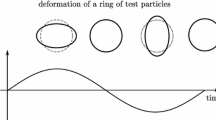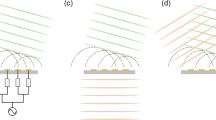Abstract
Short dipoles are a key element in new low frequency array antennas as proposed for LOFAR and other astronomical applications. Unfortunately standard texts on short dipole antennas are based on the effective area and do not lead to an astronomically useful sensitivity formulation in a straightforward manner. The concept of maximum effective area is applied to arrays of short dipoles and allows expressing the sensitivity as the ratio of this area over the effective sky brightness temperature as long as the output noise power is dominated by the antenna input radiation. For both quantities we only need to know the array directivity pattern that includes the mutual coupling effects when the actual loading conditions of the array elements are taken into account. Short dipole elements have a constant directivity pattern for frequencies below resonance, but they exhibit strong complex impedance variations that provide only narrow band performance when power matching is applied as required in transmit applications. However, in receive applications voltage or current sensing can be realized, for example with an active balun. Assisted by the steep increase of the sky brightness with wavelength for frequencies below 300 MHz, this can provide sky noise dominated performance over at least a three to one frequency range. Still the low frequency limit is determined by the amplifier noise contribution and the losses in the antenna and in the dielectric ground surrounding the elements. We show that for a sparse array with the elements non-uniformly distributed according to an exponential shell model, a constant sensitivity can be obtained over a frequency range of at least two octaves. In addition, such a configuration has a factor of six greater sensitivity than a rectangular array for a large part of the frequency band.
Similar content being viewed by others
References
Balanis, C.A.: 1997, Antenna Theory, Analysis and Design, John Wiley & Sons, Inc., New York.
Bregman, J.D.: 2000, ‘Concept Design for a Low Frequency Array’, SPIE Proc. Astron. Telesc. Instrum., 1415, 19–32.
Bregman, J.D., Tan, G.H., Cazemier, W. and Craeye, C.: 2000, ‘A Wideband Sparse Fractal Array Antenna for Low Frequency Radio Astronomy’, IEEE Antenn. Propag. Soc. Int. Symp. 1, 166–169.
de Hoop, A.T.: 1975, Philips Res. Rep. 30, 302–315.
IEEE Standard Definitions of Terms for Antennas, IEEE Std 145–1993, The Institute of Electrical and Electronic Engineers Inc., New York.
Konovalenko, A.A. et al.: 2003, ‘Thirty-element Active Antenna Array as a Prototype of a Huge Low-Frequency Radio Telescope’, Exp. Astron. 16, 149–164.
Kraus, J.D.: 1988, Antennas, McGraw-Hill, New York.
Tan, G.H. and Rohner, C.: 2000, SPIE Proceedings Astronomical Telescopes and Instrumentation.
Author information
Authors and Affiliations
Corresponding author
Rights and permissions
About this article
Cite this article
Van Cappellen, W.A., Bregman, J.D. & Arts, M.J. Effective Sensitivity of A Non-uniform Phased Array of Short Dipoles. Exp Astron 17, 101–109 (2004). https://doi.org/10.1007/s10686-005-0789-x
Received:
Accepted:
Issue Date:
DOI: https://doi.org/10.1007/s10686-005-0789-x




